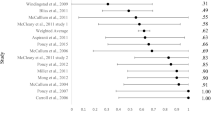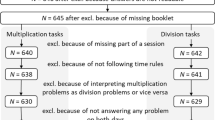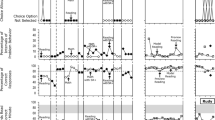Abstract
Experimental conditions were designed to examine students’ sensitivity to scheduled contingencies and accurate or fallacious rules as these variables influence performance during computer-generated math problems. Experimental subjects were provided: scheduled contingencies followed by extinction, follow-up extinction, and a rules condition promulgating accurate or fallacious rules for accessing reinforcement. Control subjects did not have access to rules; however, sensitivity to direct-acting contingencies was measured during response independent reinforcement. Performing with accurate rules and scheduled contingencies, most experimental subjects correctly answered math problems at accelerated rates and extended durations. Also, providing fallacious rules during response independent reinforcement induced high rates and extended durations of superstitious responding. However, for most students response independent reinforcement, without rules, was insufficient to induce such behavior. Evidence from this study suggests that maintenance of high rate superstitious responding requires exposure to a fallacious rule in conjunction with making contact with response independent reinforcement. Implications from this study support the theory that superstitious behavior may become self-sustaining by precluding one’s opportunities to contact the null effects of not performing in accordance with fallacious rules. Ramifications regarding interactions between verbal fallacies and coincidental reinforcement are discussed.
Similar content being viewed by others
References
BARON, A., PERONE, M., & GALIZIO, M. (1991). Analyzing the reinforcement process at the human level: Can application and behavioristic interpretation replace laboratory research? The Behavior Analyst, 14, 95–105.
CATANIA, A. C., MATTHEWS, B. A., & SHIMOFF, E. (1982). Instructed versus shaped human behavior: Interactions with nonverbal responding. Journal of the Experimental Analysis of Behavior, 38, 233–248.
CATANIA, A. C., SHIMOFF, E., & MATTHEWS, B. (1989). An experimental analysis of rule-governed behavior. In S. C. Hayes (Ed.), Rule-governed behavior: Cognition, contingencies, and instructional control (pp. 119–150). New York: Plenum Press.
CERUTTI, D. T (1991). Discriminative versus reinforcing properties of schedules as determinants of schedule insensitivity in humans. The Psychological Record, 41, 51–67.
EDGINGTON, Eugene S. (1995). Randomization tests. New York, NY: Marcel Dekker, Inc.
FISHER, W. W., NINNESS, H. A. C., PIAZZA, C. C., & OWEN-DESCHRYVER, J. S. (1996). On the reinforcing effects of the content of verbal attention. Journal of Applied Behavior Analysis, 29, 235–238.
FISHER, W. W., PIAZZA, C. C., Zarcone, J. R., O’CONNER, J., & NINNESS, H. A. C. (1995, May). On the clinical and theoretical implications of molar and molecular functional assessment. Paper presented at the 21st Annual Convention of the Association for Behavior Analysis International, Washington, DC.
HACKENBERG, T D., & JOKER, V. R. (1994). Instructional versus schedule control of human choices in situations of diminishing returns. Journal of the Experimental Analysis of Behavior, 62, 367–383.
HAGOPIAN, L. P., FISHER, W. W., & LEGACY, S. M. (1994). Schedule effects of noncontingent reinforcement on attention-maintained destructive behavior in identical quadruplets. Journal of Applied Behavior Analysis, 27, 317–325.
HASTINGS, R. P., REMINGTON, B., & HALL, M. (1995). Adults’ responses to self-injurious behavior. Behavior Modification, 19, 425–450.
HAYES, S. C., ZETTLE, R. D., & ROSENFARB, I. (1989). Rule following. In S. C. Hayes (Ed.), Rule-governed behavior: Cognition, contingencies and instructional control (pp. 191–220). New York: Plenum.
HELTZER, R. A., & VYSE, S. A. (1994). Intermittent consequences and problem solving: The experimental control of “superstitious” beliefs. The Psychological Record, 44, 155–169.
LEE, V. L. (1996). Superstitious location chances by human beings. The Psychological Record, 46, 71–86.
MALOTT, R. W., WHALEY, D. L., & MALOTT, M. E. (1997). Elementary principles of behavior: Third edition. Upper Saddle River, NJ: Prentice Hall.
NEWMAN, B., BUFFINGTON, D. M., & HEMMES, N. S. (1995). The effects of schedules of reinforcement on instruction following. The Psychological Record, 45, 463–476.
NINNESS, H. A. C., GLENN, S. S., & ELLIS, J. (1993). Assessment and treatment of emotional or behavioral disorders. Westport, CT: Praeger.
ONO, K. (1994). Verbal control of superstitious behavior: Superstitions as false rules. In S. C. Hayes, L. J. Hayes, M. Sato, & K. Ono (Eds.), Behavior analysis of language and cognition (pp. 181–196). Reno, NV: Context Press.
ROSENFARB, I. S., NEWLAND, M. C., BRANNON, S. E., & HOWEY, D. S. (1992). Effects of self-generated rules on the development of schedule-controlled behavior. Journal of the Experimental Analysis of Behavior, 58, 107–121.
SCHLINGER, H., & BLAKELY, E. (1987). Function altering effects of contingency-specifying stimuli. The Behavior Analyst, 10, 41–45.
SKINNER, B. F. (1948). “Superstition” in the pigeon. Journal of Experimental Psychology, 38, 168–172.
STADDON, J. E. R., & SIMMELHAG, V. L. (1971). The “superstition” experiment: A reexamination of its implications for the principles of adaptive behavior. Psychological Review, 78, 3–43.
VYSE, S. A. (1991). Behavioral variability and rule generation: General, restricted, and superstitious contingency statements. The Psychological Record, 41, 487–506.
Author information
Authors and Affiliations
Corresponding author
Additional information
This investigation was supported in part by a Stephen F. Austin State University Faculty Research Grant 1-14065.
We gratefully acknowledge the helpful comments provided by Cloyd Hyten, Glen McCuller, and Eugene Edgington in the development of this study.
Rights and permissions
About this article
Cite this article
Ninness, H.A.C., Ninness, S.K. Superstitious Math Performance: Interactions between Rules and Scheduled Contingencies. Psychol Rec 48, 45–62 (1998). https://doi.org/10.1007/BF03395258
Published:
Issue Date:
DOI: https://doi.org/10.1007/BF03395258




